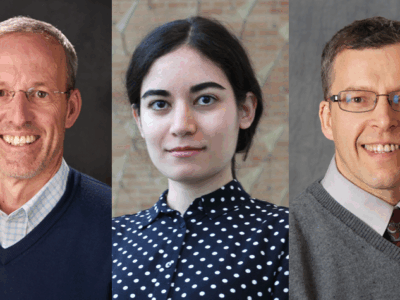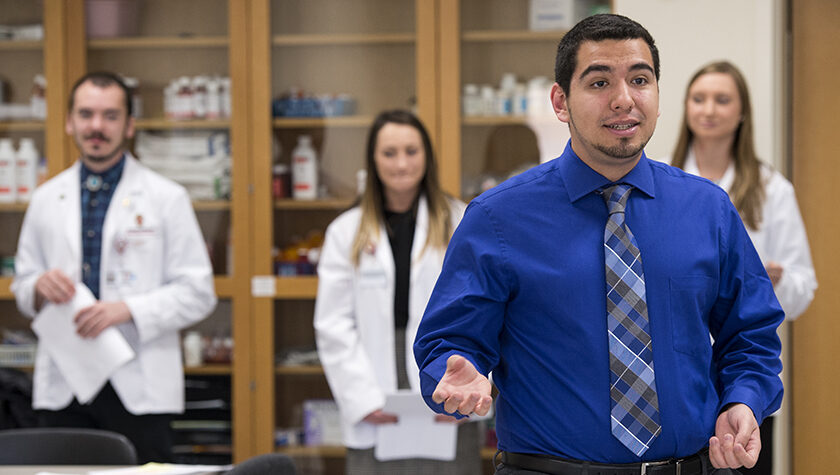
9
June

Two new APPE rotations, built in partnership with WARM, strengthen the School’s Rural Health PharmD option
By Emma Gran
Beginning in May 2021, the University of Wisconsin–Madison School of Pharmacy is introducing two new Advanced Pharmacy Practice Experience (APPE) rotations to immerse student pharmacists in rural practice. The new sites, both in Tomah, Wis., serve as a capstone experience for the Rural Health Named Option in the PharmD program.
The new rural APPEs, developed in partnership with the Wisconsin Academy for Rural Medicine (WARM) program at the UW School of Medicine and Public Health, include two sites for students to choose between: the Gundersen Tomah Clinic or Tomah Health Medical Center. Between the two sites, there are enough rotations available for each of the pharmacy students in the School’s Rural Health PharmD program.
“We are really at the forefront of demonstrating what our students can do in rural areas.”
—Ed Portillo
“These rotations have been designed for our students to learn from exceptional, innovative rural healthcare practitioners across many disciplines. Throughout the process, students are applying their clinical and leadership skillset as members of the rural healthcare team,” says Ed Portillo (PharmD ’14), assistant professor in the School of Pharmacy’s Pharmacy Practice Division, who helped develop the Rural Health program.
“The interprofessional approach taken to develop these rotations, and the wonderful partnerships that we have formed, will be critical to student learning,” says Portillo. “We are really at the forefront of demonstrating what our students can do in rural areas.”
Innovating rural care
The Rural Health program, open to PharmD students in their third year, begins with a year of didactic courses specializing in rural health, project management, and service implementation incorporating a longitudinal project. In their fourth year, students in the Rural Health program complete at least two of their eight APPE rotations in a rural environment.
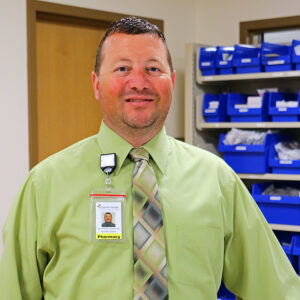
“In rural America patients have less access to health care, especially specialty care and primary care services, as compared to their urban counterparts,” says Portillo. That presents an opportunity to design creative care models to emphasize the strengths of every profession on the care team, including pharmacists.
“Within the Rural Health program, we can build and demonstrate new care models, with our PharmD students really leading the way and understanding how team-based health care delivery will improve access to care and care coordination,” says Portillo. “The only way to do this work is through collaborative partnerships, like what we have formed between the School of Pharmacy and the Wisconsin Academy of Rural Medicine.”
Through the newly developed rotations, student pharmacists will have a heavily interprofessional experience, working side-by-side with medical students to expand their understanding of rural care.
“In these new APPEs, we’re building models of care that are not commonly seen in healthcare delivery,” he says. “Our students are the ones testing and moving forward new models of interprofessional care.”
Interprofessional experiences
Mathew Heule was the first PharmD student to start the rotation at Tomah Health. Just a week into the six-week rotation, the unique aspects of the APPE were clear.
“I’ve already been able to see a mix of everything related to pharmacy: business decisions, product preparation, sterile compounding, product delivery, chart monitoring, and so on,” Heule says.
Heule particularly enjoys working collaboratively with the nurses in the infusion center. Close communication between pharmacy and nursing staff is required to ensure medications are prepared for patients returning for infusions after meeting with an oncologist in the Gundersen Tomah Clinic next door.
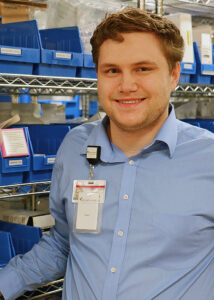
“My main interest in rural pharmacy practice is due to the smaller hospital sizes,” Heule says. “Many of my experiences here are things that are not seen in larger hospitals.”
For example, on his first day, preceptor Todd Chapman (PharmD ’04), director of pharmacy services, introduced Heule to everyone working at the hospital. Those introductions build community and serve as the starting point of collaborative relationships.
“This APPE gives students the opportunity to see what rural hospitals have to offer and what the environment is like,” says Chapman. “Rural health is unpredictable work. You can see a lot of different things in one day at a rural, critical access hospital; we do everything.”
In rural practice, pharmacists are one of few members of the health care team, working closely with physicians, nurses, and other providers to provide seamless care. In some cases, they’re the only pharmacist on the team.
To reflect this, pharmacy students at the Gundersen Tomah Clinic don’t have an on-site pharmacist preceptor — instead, they’ll be supervised by a physician, Kelly Hodgson Kline, and will connect virtually with pharmacist Adam Gregg. The clinic has never had an on-site pharmacist, so the pharmacy student will be filling the role for the first time.
“This is groundbreaking in that we’re inserting a student pharmacist into their care model, and we’re going to learn a lot about what our students are doing to enhance care in that setting, working with a wonderful group of physicians,” says Portillo.
Sierra Kuehl is the first PharmD student to complete the Gundersen Tomah Clinic rotation, and she says it’s been enlightening to see how physicians review patients, initiate therapies, and prescribe medications. As a student pharmacist, she’s learning how to use her medication expertise to establish her position on the healthcare team.
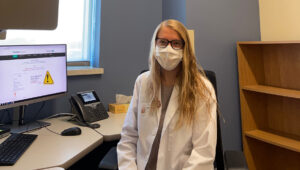
“This has been a wonderful learning environment for me and has allowed me to discover alternative ways to find answers, whether that be utilizing medication resources or having an open discussion with the physicians,” says Kuehl.
She and Gregg, the pharmacist preceptor, meet virtually at the end of each day to consider patient cases through a pharmacist’s lens, diving deeper into disease states and therapies.
Born and raised in Tomah, Chapman is excited to see the development of more rural-focused programs drawing the next generation of health care providers back into smaller towns.
“A lot of UW students are raised in smaller communities with critical access hospitals,” he says. “Giving them the opportunity to see how they work and the dedication throughout the facility to take care of patients from their own community is a special thing.”


